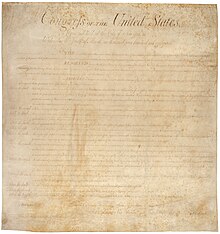
Back وثيقة حقوق الولايات المتحدة Arabic وثيقة حقوق امريكا ARZ Hüquqlar haqqında Bill (ABŞ) Azerbaijani Біль аб правах (ЗША) Byelorussian Закон за правата (САЩ) Bulgarian Declaració de Drets de la Constitució dels Estats Units Catalan Listina práv (Spojené státy americké) Czech Bill of Rights (Vereinigte Staaten) German Διακήρυξη των Δικαιωμάτων του Πολίτη Greek Bill of Rights (Usono) Esperanto
| United States Bill of Rights | |
|---|---|
 First page of an original copy of the twelve proposed articles of amendment, as passed by Congress | |
| Created | September 25, 1789 |
| Ratified | December 15, 1791 |
| Location | National Archives |
| Author(s) | 1st United States Congress, mainly James Madison |
| Purpose | To amend the Constitution of the United States |
| This article is part of a series on the |
| Constitution of the United States |
|---|
 |
| Preamble and Articles |
| Amendments to the Constitution |
|
Unratified Amendments: |
| History |
| Full text |
The United States Bill of Rights comprises the first ten amendments to the United States Constitution. Proposed following the often bitter 1787–88 debate over the ratification of the Constitution and written to address the objections raised by Anti-Federalists, the Bill of Rights amendments add to the Constitution specific guarantees of personal freedoms and rights, clear limitations on the government's power in judicial and other proceedings, and explicit declarations that all powers not specifically granted to the federal government by the Constitution are reserved to the states or the people. The concepts codified in these amendments are built upon those in earlier documents, especially the Virginia Declaration of Rights (1776), as well as the Northwest Ordinance (1787),[1] the English Bill of Rights (1689), and Magna Carta (1215).[2]
Largely because of the efforts of Representative James Madison, who studied the deficiencies of the Constitution pointed out by Anti-Federalists and then crafted a series of corrective proposals, Congress approved twelve articles of amendment on September 25, 1789, and submitted them to the states for ratification. Contrary to Madison's proposal that the proposed amendments be incorporated into the main body of the Constitution (at the relevant articles and sections of the document), they were proposed as supplemental additions (codicils) to it.[3] Articles Three through Twelve were ratified as additions to the Constitution on December 15, 1791, and became Amendments One through Ten of the Constitution. Article Two became part of the Constitution on May 5, 1992, as the Twenty-seventh Amendment. Article One is still pending before the states.
Although Madison's proposed amendments included a provision to extend the protection of some of the Bill of Rights to the states, the amendments that were finally submitted for ratification applied only to the federal government. The door for their application upon state governments was opened in the 1860s, following ratification of the Fourteenth Amendment. Since the early 20th century both federal and state courts have used the Fourteenth Amendment to apply portions of the Bill of Rights to state and local governments. The process is known as incorporation.[4]
James Madison initially opposed the idea of creating a bill of rights, primarily for two reasons:
1. The Constitution did not grant the federal government the power to take away people’s rights. The federal government’s powers are “few and defined” (listed in Article I, Section 8 of the Constitution). Any powers not listed in the Constitution reside with the states or the people themselves.[5][6][7]
2. By creating a list of people’s rights, then anything not on the list was therefore not protected. Madison and the other Framers believed that we have natural rights and they are too numerous to list. So, writing a list would be counterproductive.[8][9]
However, opponents of the ratification of the Constitution objected that it contained no bill of rights. So, in order to secure ratification, Madison agreed to support adding a bill of rights, and even served as its author. He resolved the dilemma mentioned in Item 2 above by including the 9th Amendment, which states that just because a right hasn’t been listed in the Bill of Rights doesn’t mean that it doesn’t exist.[10]
There are several original engrossed copies of the Bill of Rights still in existence. One of these is on permanent public display at the National Archives in Washington, D.C.
- ^ Bryan, Dan (April 8, 2012). "The Northwest Ordinance of 1787 and its Effects". American History USA. Retrieved February 23, 2023.
- ^ "Bill of Rights". history.com. A&E Television Networks. Archived from the original on February 25, 2019. Retrieved February 24, 2019.
- ^ England, Trent; Spalding, Matthew. "Essays on Article V: Amendments". The Heritage Foundation. Archived from the original on July 1, 2018. Retrieved February 24, 2019.
- ^ "Bill of Rights – Facts & Summary". History.com. Archived from the original on December 8, 2015. Retrieved December 8, 2015.
- ^ Rossiter, Clinton, ed. The Federalist Papers, p. 260, Federalist #45, Penguin Putnam, Inc., 1961.
- ^ Samples, John, ed. James Madison and the Future of Limited Government, p. 25, 29-30, 31, 34, Cato Institute, Washington, D.C., 2002. ISBN 1-930865-23-6.
- ^ Ketcham, Ralph. James Madison: A Biography, p. 226, American Political Biography Press, Newtown, Connecticut, 1971. ISBN 0-945707-33-9.
- ^ Ketcham, Ralph. James Madison: A Biography, p. 226, 291, American Political Biography Press, Newtown, Connecticut, 1971. ISBN 0-945707-33-9.
- ^ Samples, John, ed. James Madison and the Future of Limited Government, p. 27, 29-30, 31, 34, Cato Institute, Washington, D.C., 2002. ISBN 1-930865-23-6.
- ^ The Constitution of the United States and the Constitution of the State of California, p. 56, California Legislature Assembly, 1989.